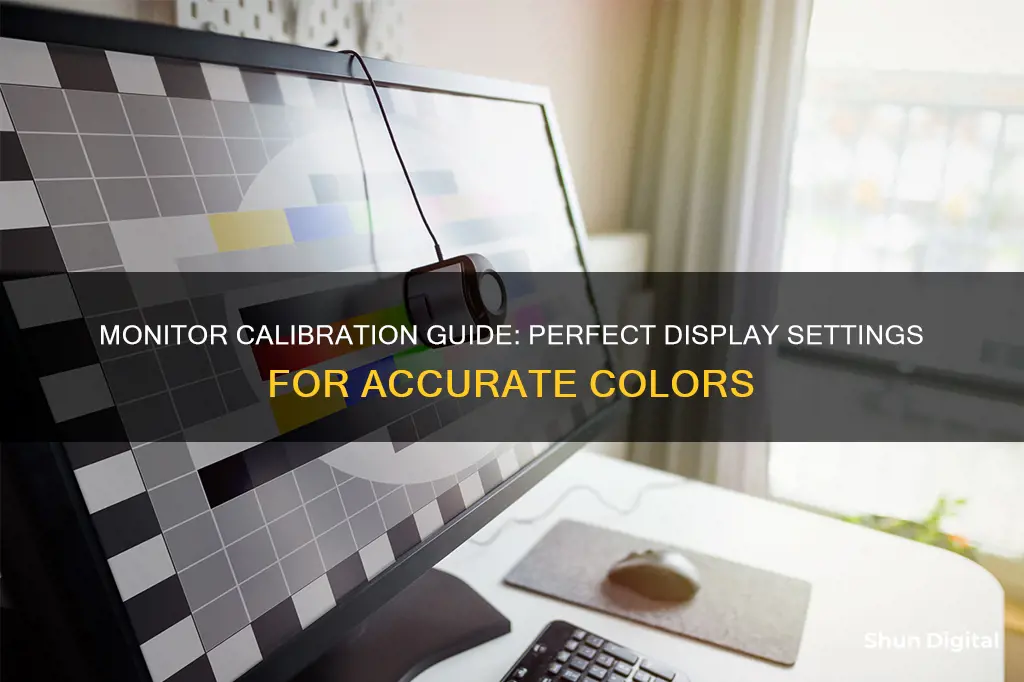
Calibrating your monitor is an important step to ensure that your display is optimised for your needs. Whether you're a professional photographer or graphic artist, or just someone who wants their display to look its best, calibration can help fix issues with colour accuracy, brightness, and sharpness. While calibrating your monitor can be done by eye, it can be a tricky and time-consuming process. This is where monitor calibration tools come in, which can guide you through the process and help you adjust settings like brightness, contrast, and colour balance. In this article, we'll be covering everything you need to know about calibrating your monitor, from built-in tools in Windows and macOS to more advanced third-party solutions.
| Characteristics | Values |
|---|---|
| Calibration tools | Built-in Windows and Mac tools, online tools, colorimeter hardware |
| Calibration settings | Brightness and contrast, picture mode, sharpness, color temperature, white balance, ICC profiles |
| Calibration steps | Turn on the monitor, set the monitor's resolution to its native resolution, calibrate in a room with moderate ambient lighting, familiarise yourself with the monitor's display controls |
What You'll Learn

Calibrating your monitor by eye
Step 1: Preparation
Before you begin, there are a few things you need to do to prepare your monitor and the space around it:
- Turn on your monitor and let it warm up for at least 30 minutes. This ensures that it has reached its normal operating temperature and conditions.
- Set your monitor's resolution to its native, default screen resolution. This can be done on both Windows and macOS.
- Calibrate your monitor in a room with moderate ambient lighting. Avoid direct light to prevent sharp glares and colour casts.
- Familiarise yourself with your monitor's display controls. These may be located on the monitor itself, on your keyboard, or within the operating system control panel. Some displays even come with remote controls.
Step 2: Using Built-in Tools
Both Windows and macOS offer built-in calibration tools that guide you through the process. These are a great option if you're new to monitor calibration or on a tight budget. Here's how to use them:
- Windows: Open the Display Color Calibration tool by searching for "calibrate display colour" in the Windows search bar. Follow the on-screen instructions to adjust your display's gamma, brightness, contrast, and colour balance settings.
- MacOS: Use the Display Calibrator Assistant, found in System Preferences > Displays > Colour > Calibrate. Follow the step-by-step instructions to adjust the white point, colour adjustments, and administrator access. Name your profile so you can recognise it in the future.
Step 3: Using Online Tools
If you want more precise or customised calibration, you can use online tools such as:
- W4zt Screen Color Test: This webpage provides colour gradients and grayscale boxes for quick comparisons, along with a gamma test.
- Photo Friday: Offers a simple calibration tool to adjust your brightness and contrast, with all the information you need to get your settings just right.
- FlatPanels Online Monitor Test: A comprehensive range of tests to help you calibrate your monitor's contrast, brightness, colour strengths, gamma, and more.
Step 4: Fine-Tuning
Once you've made adjustments using the built-in or online tools, it's time to fine-tune your settings:
- Brightness and Contrast: Use a near-black gradient test pattern to adjust your brightness. Raise or lower the setting until the 17th step disappears, then go back one step to make it visible again.
- Sharpness: If you're not happy with the default sharpness, set it to the maximum and then lower it until no strange patterns form between the lines and shapes of the test image.
- Colour Temperature: Adjust the colour temperature to your preference. A cooler temperature gives a blue tint, while a warmer temperature leans towards yellow or orange. The standard for most screen calibrations is 6500k, equivalent to midday light.
Remember, calibrating your monitor by eye is a trial and error process, so don't be afraid to experiment until you get the results you're happy with. Most monitors have a reset feature if you want to start over.
Snowden's Warning: CIA Monitoring and Surveillance
You may want to see also

Using a colour calibrator
A colour calibrator, also known as a colourimeter or tristimulus colourimeter, is a small device that fastens to your screen. It works with calibration software to optimise display colour for your particular screen and your room's lighting conditions. Devices like the Datacolor Spyder and the X-Rite ColorMunki measure the ambient light in your room and recommend optimal calibration settings.
Before you begin the calibration process, let your monitor warm up for about 30 minutes. Avoid shining direct light on your monitor, and make sure the ambient lighting conditions are similar to those when you perform colour adjustments on your work.
The first thing your software will do is ask you to specify your monitor type and target settings. The white point is the temperature setting (measured in degrees Kelvin) that determines the warmth or coolness of your whites. If you're working with video on an LCD monitor, the recommended white point is 6500K or D65, which is also the native temperature of your monitor. If you're working with still images that you plan to print, the white point of 5000K (D50) is recommended as it looks more like white on paper.
Gamma is the rate at which shades go from black to white. A higher gamma value has the same extremes of black and white as a lower gamma value, but it will produce greater contrast within that range. The recommended gamma setting depends on how you expect your video to be watched. For a screen in a bright room, like an office, the recommended display setting is 2.2. This is the standard setting for Mac and Windows machines. For screens in dark rooms like home theatres, the recommended setting is 2.4 as, in a darker room, contrast is easier to see.
Luminance is the intensity of the light emitted by the screen, also known as brightness. It's important to keep this setting consistent when you're doing colour correction so that you don't correct one scene at one brightness level and another at a different level. The recommended brightness for a standard LCD screen is 120.
Once you've confirmed your monitor settings, the automatic calibration process will begin. The colourimeter will test your monitor's colours against industry colour standards, map the variations, and create a unique colour profile (also known as an ICC profile) for your monitor. With an accurate profile, you can pinpoint exact shades of colour and communicate those across devices.
Professional colourists recommend calibrating displays at least once a month to ensure colours stay consistent, especially as your monitor degrades and its colours change over time.
Oxygen Tip Monitor Buying Guide: Where to Purchase
You may want to see also

Using built-in Windows and Mac tools
Both Windows and Mac operating systems have built-in calibration tools to help guide you step-by-step through the process, which is particularly helpful if you are new to monitor calibration. These free tools should be the first stop if you’re merely a casual user or working on a tight budget. Keep in mind that the adjustments will be limited by the display type and model.
Windows
In the latest versions of Windows, the easiest way to find the colour calibration tool is through the Windows search bar. Type "Calibrate" into the Windows search bar and select "Calibrate display colour" from the results. On Windows 10, search for "Colour Calibration" and select the corresponding result.
In older versions of Windows, you can find the Colour Calibration utility in the Display section of the Control Panel, which is listed under Appearance and Personalization.
Once you are in the calibration tool, follow the on-screen instructions to choose your display’s gamma, brightness, contrast, and colour balance settings. A sample image for you to match will accompany many of the settings. Simply make adjustments to mimic the sample as closely as possible.
Once the calibration wizard is complete, make sure to choose the Current calibration, or return to the previous calibration if you are unsatisfied with the results. The new calibration will be stored as an .ics file, or colour calibration file, and will show up as a new International Colour Consortium (ICC) Profile in the Colour Management settings app.
Mac
On a Mac, go to System Preferences > Display and click on the Color tab. Next, click the Calibrate button, which opens the Display Calibrator Assistant. It walks you through calibrating your display and then creates a calibrated colour profile.
There is a box you can check for Expert Mode. If you leave this option unchecked, you will access only two settings: target gamma and white point. And, really, it's only one setting because target gamma — a fancy term for "contrast" — in most cases, should be left at the standard 2.2 setting.
So, to access more settings, let's go back and check the box for Expert Mode. Now, we can access five test patterns to tweak the native gamma — or luminance — of your display. Next, you have more options for the target gamma, but the Mac standard gamma of 2.2 is still recommended. Similarly, there are more options for the white point, which adjusts the overall colour tint of the display. Again, unless you are engaging in particular graphics work that requires an odd setting, it's probably best to use the native white point. Lastly, Expert Mode lets you act as an administrator and choose whether to allow other users access to this calibration profile.
To finish up, give your profile a name and click Done. Your new profile will now be listed as an option on the Color tab of the Display option in System Preferences.
Stretched Resolution: Remove Black Bars for Immersive Viewing
You may want to see also

Calibrating for brightness and contrast
Calibrating your monitor can help fix a range of issues, including dull colours, overly bright or sharp screens, fuzzy fonts, washed-out images, and poor shadow detail. While you can pay for a professional to calibrate your monitor, or buy the equipment to do it yourself, this can be expensive. However, there are free ways to calibrate your monitor, including using built-in Windows and Mac tools.
Brightness and contrast are the most important settings to get right when calibrating your monitor.
The brightness setting affects how the monitor displays darker colours. If the brightness is set too high, black colours will appear grey, and the image will have less contrast. If it's set too low, the blacks will get "crushed", meaning that instead of showing distinct near-black steps of grey, the monitor will instead show them as pure black. This can give the image a very high-contrast look at first glance, but it loses a lot of detail.
The best way to adjust brightness is by using a near-black gradient test pattern. Raise or lower the brightness setting until the 17th step disappears completely, then go back one step so it's visible again.
The contrast setting is very similar to the brightness setting, but it affects the brighter parts of the image. If the contrast is set too high, brighter images will "clip", which is similar to crushing. Setting it too low will darken the image and reduce contrast.
To calibrate for contrast, adjust the setting until steps up to 234 show some visible detail. The last few steps should be faint, so this may take some trial and error.
Calibration Tools
There are a variety of online calibration tools that can help you manually adjust your monitor settings, including W4zt Screen Colour Test, Photo Friday, and FlatPanels Online Monitor Test.
Both Windows and Mac have built-in calibration tools that are particularly helpful if you're new to monitor calibration. In Windows 11, type "Calibrate" into the search bar and select "Calibrate display colour" from the results. In Windows 10, search for "Colour Calibration" and select the corresponding result. In older versions of Windows, you can find the Colour Calibration utility in the Display section of the Control Panel, under Appearance and Personalization.
For macOS, the Display Calibrator Assistant is located in the System Preferences under the Displays tab, in the Colour section. If you're having trouble finding it, try entering "calibrate" in Spotlight to scan through your computer's folders and files.
Setting Up Studio Monitors: A Beginner's Guide
You may want to see also

Using online tools
There are a variety of online tools that can help you calibrate your monitor. These tools can provide more precise or more customised calibration than the built-in utilities.
W4zt Screen Color Test
This simple webpage provides you with several colour gradients and grayscale colour boxes that you can use for quick comparisons, along with an easy gamma test. It's nice to have so many tests on one page, making this solution great for a fast and efficient calibration.
Photo Friday
Photo Friday has a simple calibration tool that will give you a great reference for your own calibrations. It won't do it for you, but it has all the information you need to get your contrast, gamma, and brightness just right. It is a one-page monitor calibration tool to adjust the brightness and contrast of your screen thanks to the grayscale tones. The idea is to tweak the monitor settings so that you can clearly distinguish the transition of tones from true black to true white. After calibration, the blacks should look black and without any hint of grey.
Lagom LCD Monitor Test Pages
The Lagom LCD Monitor Test Pages are a far more comprehensive set of tools than Photo Friday. The site includes a series of test patterns that start from checking contrast to checking for response times on your monitor. It is recommended to go through the tests in the order they are placed.
For instance, use the first few images to check brightness, contrast, and sharpness. With those set, use a latter test like the “Viewing Angle” to see if the display changes brightness or colours in the corners.
Online Monitor Test
The Online Monitor Test website has a range of interactive tests to fix your screen colours. The menu appears when you move your mouse to the top. It starts off with a test that checks the brightness and contrast across the B/W tonal spectrum. It is similar to the test covered on the Photo Friday website.
Next, the Colour Range test checks if your monitor can smoothly produce colour gradients. From the menu, you can pick different colour charts. Look for “ghost images” or image trails in the Trailing test. Move the box across the screen and check if any trails are produced. The controls and options to change the colour and shape of the box are placed at the bottom.
FlatPanels Online Monitor Test
The FlatPanels range of online monitor tests are extremely comprehensive, with guides and tools to help you calibrate your monitor's contrast, brightness, various colour strengths, gamma, and more.
DryCreekPhoto.com
This site features a simple test to check if your monitor's black point is set correctly and to also find the minimum shadow level it can display.
Monitor Calibration and Gamma Assessment
This page and the associated test are devoted to Gamma values. The author also provides a series of "Gamagic" test patterns you can use to calibrate your monitor. Fall back on your eyes and adjust the gamma setting with the monitor controls until all the squares match up with their backgrounds as closely as possible.
Eizo
This site features several quick checks that you can perform with the images provided. This includes colour, grayscale, and gamma adjustments.
Replacing Lenovo 900 Yoha's LCD Monitor: A Step-by-Step Guide
You may want to see also
Frequently asked questions
You can calibrate your monitor by adjusting the brightness, contrast, and gamma. Windows and macOS have built-in calibration tools to help guide you through the process.
Calibration can fix common monitor issues such as lackluster colors, overly bright or sharp displays, fuzzy fonts, and washed-out streaming movies.
The easiest way to calibrate your monitor is to use the built-in calibration tools in Windows or macOS. In Windows 11, type "calibrate" in the search bar and select "Calibrate display color". In macOS, the Display Calibrator Assistant is located in the System Preferences under the Displays tab.
Calibration can be done for free using the built-in tools in Windows or macOS, or with online tools. However, purchasing a calibrating device for more accurate results can cost anywhere from $70 to $600.
It is recommended to calibrate your monitor once a month, as accuracy can drift over time due to panel degradation.







